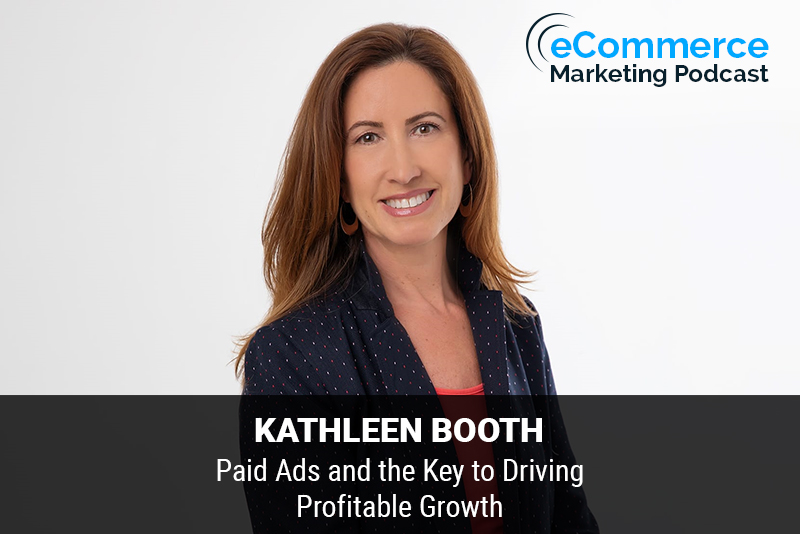
The eCommerce Marketing Podcast walks you through everything that goes into ecommerce marketing — from inbound marketing to paid advertising to conversions. Learn the strategies top marketing experts use to grow their businesses.
Today’s guest is Kathleen who is the SVP of Marketing at Tradeswell, where she’s on a mission to empower a new generation of digital-first marketplace brands. Prior to joining Tradeswell, she led marketing at several VC-backed B2B SaaS businesses in the ecommerce and cybersecurity spaces, and was the founder and CEO of a digital marketing agency where she advised hundreds of companies on go-to-market and digital marketing strategies. Outside of work, Kathleen is the host of the long running Inbound Success Podcast, which features interviews with top performing marketers, and was named one of the Top 50 B2B Marketing Influencers of 2021 by TopRank.
In this episode, you will learn
- What internal things need to be in alignment before launching your paid ad campaigns
- How exactly does data unification and speed result in profitable growth from paid ads
- How does an ecommerce brand determine what paid ad platforms will be right for their business
- Examples of businesses that have launched successful paid ad campaigns and the things they did to become successful
For show transcript and past guests, please visit https://www.ecommercemarketingpodcast.com
Or on YouTube at:
https://www.youtube.com/channel/UC3PgT0NOGzpdPGQtBK0XLIQ
Follow Arlen:
Twitter: https://twitter.com/askarlen
Facebook: https://www.facebook.com/arlen.robinson.7
Instagram: https://www.instagram.com/arlenyohance/
LinkedIn: https://www.linkedin.com/in/arlenrobinson/
Past guests on the ecommerce marketing podcast include Neil Patel, Nemo Chu, Luke Lintz, Luke Carthy, Amber Armstrong, Kris Ruby and many more.
Thanks for listening. Be sure to subscribe and leave a review.

In this episode of the eCommerce Marketing Podcast, host Arlen Robinson talks to Kathleen Booth, SVP of Marketing at Tradeswell. Kathleen discusses her journey from running a digital marketing agency to her current role, focusing on optimizing paid ads and unifying data to grow profitable eCommerce companies. Kathleen highlights the importance of aligning data from various channels and using it effectively to drive marketing decisions.
Key Takeaways:
- Introduction to Kathleen Booth (00:00:57)
- Kathleen’s background in digital marketing, eCommerce, and her current role at Tradeswell.
- Importance of Data in Paid Advertising (00:03:14)
- Why data is crucial for making informed decisions in paid advertising and marketing.
- Internal Alignment Before Launching Paid Ads (00:04:00)
- Ensuring brand voice and messaging are clear and having a solid data collection and analysis strategy.
- Challenges with Multiple Sales Channels (00:07:01)
- The complexity of managing ads and sales across various channels like Facebook, Google, TikTok, Shopify, and Amazon.
- Unifying Data Across Channels (00:11:16)
- The importance of marrying data from different sources to get a clear view of product performance.
- Experimentation in Advertising (00:18:19)
- Testing different ad platforms and strategies to find what works best for your brand.
- Top Factors Hindering Growth (00:21:28)
- Lack of cross-functional visibility into data, need for unified data, and AI-powered insights for quicker decision-making.
- Measuring True Advertising Effectiveness (00:22:20)
- Moving beyond Roaz to metrics like net margin contribution and integrating finance and inventory data with marketing data.
- Examples of Data-Driven Decision Making (00:26:11)
- How companies can use integrated data to optimize their advertising campaigns and drive profitability.
Bullet Points of Key Takeaways with Timestamps:
- [00:00:57] Introduction to Kathleen Booth and her experience in digital marketing.
- [00:03:14] The crucial role of data in making marketing decisions.
- [00:04:00] Internal alignment needed before launching paid ads.
- [00:07:01] Challenges in managing multiple sales channels.
- [00:11:16] Importance of unifying data from different channels.
- [00:18:19] Necessity of experimenting with different ad platforms.
- [00:21:28] Top factors hindering growth and the need for unified data and AI insights.
- [00:22:20] Measuring ad effectiveness beyond Roaz.
- [00:26:11] Examples of companies successfully using data for decision-making.
Guest Information:
Kathleen Booth
- SVP of Marketing at Tradeswell
- Website: Tradeswell.com
- LinkedIn: Kathleen Booth on LinkedIn
- Twitter: @KathleenLBooth











